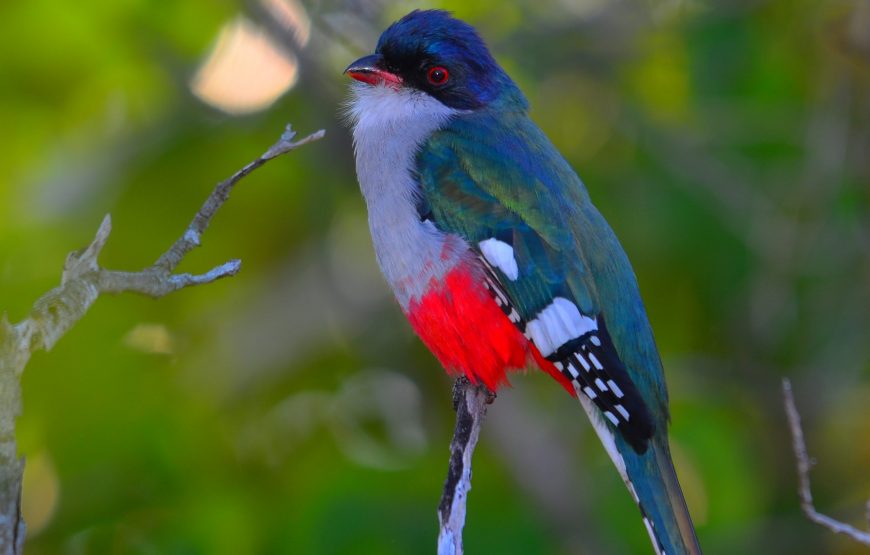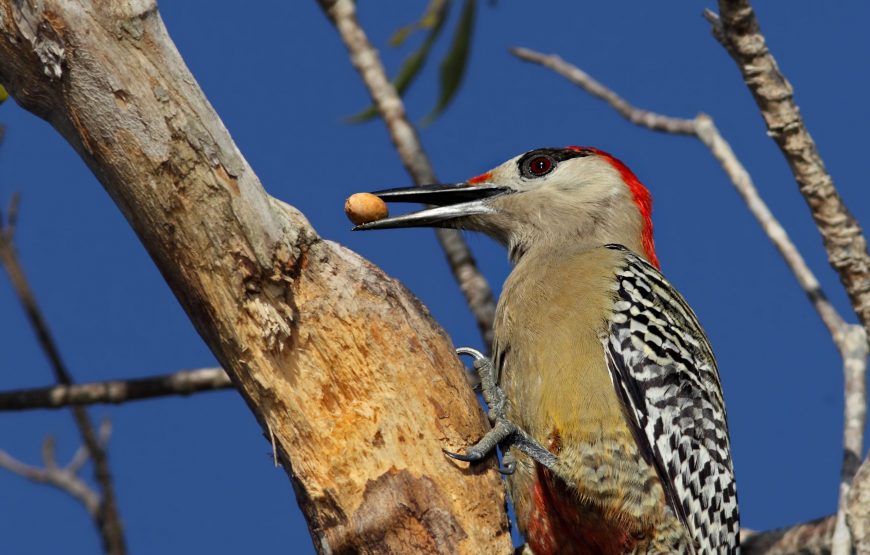from 0 review
10 Days
Specific Tour
13 people
English, Espanol






















Discover Cuba’s colorful treasures when you tour the homes of Cuba’s most important migratory and local birds. Step into nature conservatories where these beautiful birds are protected, enjoying them up close and personal.
| # | Discount group | From adult | To adult | Value |
|---|---|---|---|---|
| 1 | 9-13 Person | 9 | 13 | 17,45454545454545% |

Adjust your hat – put on your sunglasses, your birdwatching Cuba trip is about to begin! You’ll arrive in beautiful Havana shortly – and your adventure will begin. Get ready to climb aboard your chariot – well, your minibus – which will take you all over this beautiful region. As your plane touches down, you’ll start to smell tropical flowers, and feel warm breezes through your hair. Your driver will pick you up and take you to your hotel, where you’ll check in and be free to explore the beauty of Old and New Havana. From its gorgeous squares full of ancient colonial architecture, to its friendly people and out of this world food, you’ll be so charmed by this wonderful country’s beautiful sights, sounds, smells, and tastes! Get ready for an amazing trip across the wilds of Cuba – you’ll be leaving tomorrow, and we guarantee, the birds you see will be among the most beautiful in the world!

From the city of Havana, you’ll head westwards into Pinar del Río Province. As you travel, you’ll take in the amazing sights of several wetlands while keeping a lookout for Snail Kite hovering or perched around these lakes, migrant waterfowl (common species include Ring-necked Duck, Lesser Scaup and Blue-winged Teal) and wading birds such as Limpkin, Greater and Lesser Yellowlegs, Spotted Sandpiper and Tricolored, Little Blue and Green Herons. The birds and flowers within these natural areas are beyond beautiful – you’ve never seen such colour and beauty, and their natural wetland habitats boast flowers, plants, and beautiful trees that arch under the endless blue sky.
But it’s not all road travel – get ready to take in the sights and sounds of Las Terrazas Biosphere Reserve. This community-run reserve was once clear-cut for charcoal production, but millions of replanted trees have restored the area to its former grandeur delightfully colored Cuban Grassquit. This beautiful little finch is now endangered largely due to trapping for the cage-bird trade.
Keep an eye out for Cuba’s national bird, the Cuban Trogon, and the little and adorable Cuban Tody. Belonging to a family of 5 species endemic to the Caribbean and most closely related to kingfishers, this brilliantly coloured jewel of the forest may just allow you to get close enough to take a selfie! If not, you’ll be sure to find several opportunities to photograph these lovely birds. You’ll also get to see the common buff-bellied Cuban sub-species of Red-legged Thrush and Cuban Green Woodpecker. And did you know? Cuba is home to a wonder of North American wood warblers; in fact, you’ll find over five species within these woods! Particularly common are the American Redstart, Northern Parula, Palm Warbler, and Black-throated Green Warbler.

After breakfast, get ready to visit La Güira Park. This formerly glorious colonial mansion’s expansive manicured grounds offer superb birdwatching, so keep your eyes peeled as you wander the amazing grounds and take in the beautiful architecture. You’ll get to spot the colourful Western Spindalis (or Western Stripe-headed Tanager), the dumpy Cuban Bullfinch, La Sagra’s Flycatcher, Cuban (or Crescent-eyed) Pewee, Loggerhead Kingbird and the beautiful Red-legged Honeycreeper. Though she’s a rarer bird, you may get to spot the impressive Fernandina’s Flicker, too.
Time to move on! Our next port of call will be the Cuevas de Los Portales. This impressive system of limestone-formed caves is famous for hosting Ché Guevara during the Cuban Missile Crisis. The humid, vegetation covered limestone hills provide perfect habitat for Cuba’s most beautiful songbird, the Cuban Solitaire. Its gorgeous melodic, polyphonic song will more than make up for its slightly drab appearance!
Here, you’ll get a chance to see the beautiful lattice-tailed Cuban Trogon. This stunner sports Cuba’s national colours – white, red and blue (as well as a shock of green!). You’ll also see the lovely Yellow-headed Warbler, another Cuban beauty; small family groups of this wood warbler often allow you to see them right up close. The lovely Olive-capped Warbler is a denizen of tall pine trees and shares its limited range in Cuba with a population in the Bahamas.
Tonight we will settle in for the first of three nights at our lodge, nestled on the shores of Bahia de Cochinos (Bay of Pigs), a beautiful site full of tropical breezes, crystal-blue waves, and sandy beaches!

The Zapata Peninsula is the essence of Cuban birding. Large areas of this reserve now protect saltpans, mangroves, swamps and dry evergreen forests, home to most of Cuba’s endemic birds. With the help of a superb local birding guide, we will visit numerous sites and see thousands of tropical birds that will dazzle your eyes! The pinnacle of birdwatching: the world’s smallest bird, the minuscule Bee Hummingbird. Measuring in at just 2.5” (tail to bill!), this tiny hummer really does resemble a bee as it flits around flowers. Its numbers have decreased dramatically unfortunately, and it can prove a tough bird to find. We will also encounter the far more common Cuban Emerald, a sparkling green, fork-tailed nymph of the forest edge.
One of our mornings here will require an early start to reach a deciduous forest reserve where we’ll get to see 4 species of secretive and beautiful quail-doves! A local conservationist has started putting out food along a forest trail, and both the stunning Blue-headed and iridescent Grey-fronted Quail-Doves often come in to eat, giving us a rare treat. Heading down the emerald trails, we’ll also get to see the more
widespread Key West and rarer Ruddy Quail-Doves, while the attractive Zenaida Dove as well as Common Ground and Mourning Doves often nest here as well.
As we walk, we’ll keep our eyes out for the Cuban Pygmy Owl and Bare-legged (or Cuban Screech) Owl, which are usually found at known roosts. We may even see the Cuban Crow; this large, all black corvid is rather rare and our ears need to stay open for its loud and distinctive parrot-like vocalizations. Other species in this group that make this beautiful habitat home are West Indian Woodpecker, Northern Flicker (an endemic resident race) and Yellow-bellied Sapsucker. Raptors are not particularly numerous but we will keep a look out for Red-tailed and Broad-winged Hawks, Northern Crested Caracara, Merlin and of course the endemic and extremely tough Gundlach’s Hawk.
We’ll also get to visit the Zapata Swamp in the Ciénaga de Zapata National Park. Our chief target here is the very secretive Zapata Wren, a rare and beautiful wren that can be seen in these beautiful trees. It might take some patience and sharp spotting in order to obtain views of this bird, though sightings can be rare. Keep your eyes out for the attractive and fairly accommodating Zapata Sparrow as well. This is also the prime locality for the Red-shouldered Blackbird; the males are almost identical to the North American Red-winged Blackbird but the females differ in sporting all-black plumage. We will also look out for the Tawny-shouldered Blackbird and endemic Cuban Oriole (recently split from Greater Antillean Oriole, and now considered a good species to spot!).
As we wander, we’ll see the tidal flats and mangrove islets at Salinas de Brito, which are situated along the southern shore of the Zapata Peninsula. The salt water marshes are famous for their waders and waterfowl, and we will seek out the recently split Cuban Black Hawk, now a common to the region (previously considered a subspecies of Common Black Hawk). Stunningly pink American Flamingos occur in healthy numbers and we will add numerous waterbirds to our burgeoning list, including Brown Pelican, Anhinga, Reddish Egret, Roseate Spoonbill, American White Ibis, Wood Stork, Clapper Rail, Caspian and Royal Terns, Black Skimmer, Grey (Black-bellied) Plover, Short-billed Dowitcher and Least Sandpiper, among many others. Family groups of Smooth-billed Ani abound and Cuban Martins nest in dead snags on the salt flats.
You may be taken to search for the Cuban Nightjar and the impressive Stygian Owl. The latter is a dark and imposing-looking predator, so-named after the black river Styx from Greek mythology!

After a final morning of birdwatching, it’s time to go to Najasa. Sierra de Najasa and the protected reserve of Rancho La Belen. These are areas of unspoilt lowland forest and palm groves that are home to some of Cuba’s best flora and fauna. The two main species to spot here are the Cuban Palm Crow and the endangered, massive-billed Giant Kingbird (with an estimated population of less than 1000 birds). The region is also home to several other birds. Keep your camera ready for the lovely Cuban Amazon (also known as Rose-throated or Cuban Parrot) and flocks of Cuban Parakeet screeching overhead. Antillean Palm Swifts frequent the palm trees that we will be scrutinizing for the rare Cuban Palm Crow. Some of the more unusual wintering North American warblers that we may observe here include Worm-eating and Swainson's.

As our Cuban birding adventure begins to wind down, we head northwards to explore some of the thousands of small coral islets fringing Cuba. Upon reaching the coast, we will drive over a scenic 17km (10 ½ mi) causeway that separates the island of Cayo Coco from the mainland (somewhat reminiscent of Key West. During our journey we should spot large numbers of waterbirds, including the Magnificent Frigatebird, Neotropic Cormorant, Great Blue Heron, Black-crowned and Yellow-crowned Night Herons, Pied-billed Grebe, American Wigeon, American Coot, Western Osprey, Laughing Gull, Royal Tern, Belted Kingfisher, Semipalmated Plover, Killdeer, Willet, Black-necked Stilt and numerous smaller migrant waders.

Today, you’ll get to explore Cayo Coco, Cayo Guillermo, and Cayo Paredón Grande. These low-lying coral islands support a wide variety of birding habitats, ranging from stunning beaches and mangrove-lined mudflats and swamps, to low growing thorn-scrub and dwarf semi-deciduous forest in the island interior. Completely new birds will become your friends here, including the delightful Oriente Warbler, Cuban Gnatcatcher, Cuban and Thick-billed Vireos, and the scarce Bahama Mockingbird. Wandering the beaches may let you find the rare Piping Plover, Sanderling and even small flocks of Cave Swallow.

Today we depart Cayo Coco and drive back to Havana. Upon arriving in Havana, we will head out for a short walk through the historical old city. Complete with its traditional narrow streets and picturesque overhanging balconies, this beautiful old colonial port city offers a unique experience and wonderful people. Enjoy a final farewell dinner at a classic Cuban restaurant. Whether you’re into dancing, dining, shopping or simply sightseeing, Havana has it all!

After breakfast this morning, we transfer to the Jose Martí International Airport where the tour will conclude. With memories and photos of the beautiful birds you have seen, you’ll be sure to want to come back year after year to visit your newest friends, the Cuban birds!
Outerwear:
-2 long sleeved shirts (at least one that can get dirty)
-2 short sleeved shirts
-2 pair of shorts
-Hat
-Rain jacket
-Bathing suit and towels
Accessories:
-A pair of sunglasses
-Sunscreen
-Bug spray
-Camera
-Binoculars
Toiletries
-Toothbrush
-Soaps
-Other personal items
-A reasonable level of fitness is required
Leave a review